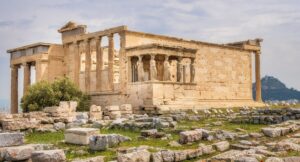Table of Contents
ToggleIntroduction
In the realm of the ancient seven wonders of the ancient world, the Statue of Zeus at Olympia stands tall as a remarkable testament to the artistic and cultural achievements of ancient Greece. Housed within the grand Temple of Zeus, this colossal statue of the king of gods mesmerized all who beheld it. In this blog, we embark on a journey to explore the historical significance, artistic mastery, and cultural impact of the Statue of Zeus at Olympia.
Olympia: Birthplace of the Olympic Games
To understand the context of the statue, we delve into the significance of Olympia as the birthplace of the ancient Olympic Games. We explore the origins of the games, their cultural importance, and the role of religious devotion in ancient Greek society.
The Temple of Zeus at Olympia
The Temple of Zeus served as the majestic setting for the statue. We delve into the architectural splendor of this grand temple, examining its design, construction, and the rituals that took place within its sacred walls.
Phidias: Master Sculptor
Phidias, the renowned ancient Greek sculptor, was responsible for creating the Statue of Zeus. We explore the life and achievements of Phidias, his artistic style, and his other notable works, which have cemented his place as one of the greatest sculptors in history.
The Creation of the Statue
We delve into the artistic process behind the creation of the Statue of Zeus, from the initial design to the selection of materials and the intricate sculpting techniques employed by Phidias and his team of skilled artisans.
The Colossal Marvel
Standing at approximately 12 meters (40 feet) tall, the Statue of Zeus at Olympia was a sight to behold. We examine its imposing presence, the use of ivory and gold to bring the deity to life, and the intricate details that showcased Phidias’ mastery of sculpting.
Symbolism and Representation
The statue was more than just a representation of Zeus; it embodied the ideals and values of ancient Greek culture. We explore the symbolism associated with Zeus and how the statue conveyed his divine power and authority.
Cultural Significance
The Statue of Zeus at Olympia played a vital role in religious and cultural life in ancient Greece. We delve into its significance as a religious icon, its connection to the Olympic Games, and its impact on the perception of the divine in Greek society.
The Fate of the Statue
Despite its grandeur, the Statue of Zeus met a tragic fate. We recount the events that led to its eventual destruction, including natural disasters, warfare, and the decline of the ancient world. Though the statue is lost to history, its legacy lives on through descriptions, drawings, and its enduring impact on art and culture.
Rumors
One rumor that has circulated regarding the Statue of Zeus at Olympia involves its fate after its creation. According to some accounts, the statue was not destroyed or lost to time, but instead removed and transported to Constantinople (modern-day Istanbul) during the Byzantine era.
These rumors suggest that the statue remained in Constantinople for centuries, becoming a treasured relic of the Byzantine Empire. It is said to have survived multiple fires and remained on display in a palace until the city’s capture by the Fourth Crusade in 1204. The statue supposedly met its demise during the sacking of Constantinople, where it was allegedly destroyed or melted down.
While these rumors of the statue’s relocation and survival in Constantinople persist, there is no concrete evidence to support these claims. The exact fate of the Statue of Zeus at Olympia remains unknown, as historical records and accounts provide no definitive answer.
It is important to approach such rumors with skepticism, as they often stem from speculation, legends, or wishful thinking. The prevailing belief is that the statue was likely destroyed or lost over time due to factors such as natural disasters, warfare, or the decay of the ancient world. Nonetheless, the rumors surrounding the statue’s potential relocation add an element of mystery to its already captivating history.
Conclusion
The Statue of Zeus at Olympia (one of the seven wonders of the ancient world), a remarkable feat of ancient Greek artistry, leaves an indelible mark on the annals of history. Through its grandeur, symbolism, and cultural significance, it serves as a testament to the artistic achievements of Phidias and the enduring legacy of ancient Greece. While the statue may be lost to time, its impact on art, culture, and our understanding of ancient civilizations remains an eternal source of inspiration and admiration.



